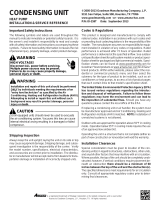
9
4. TXV-based systems should have a Subcooling value
of 6°F +/- 1°F.
5. Add refrigerant to increase Subcooling and remove
refrigerant to decrease Subcooling.
RECOMMENDATIONS
1. Clamp a pipe clamp thermometer near the suction line
service valve at the outdoor unit.
a.
for the best possible readings.
b. The temperature read with the thermometer
should be higher than the saturated suction
temperature.
2.
suction temperature and the suction line temperature
is the Superheat value.
3. TXV-based systems should have a Superheat value of
8°F +/- 1°F.
4. Adjust Superheat by turning the TXV valve stem
clockwise to increase and counterclockwise to
decrease.
a. If Subcooling and Superheat are low, adjust the
TXV to 8°F +/- 1°F, and then check Subcooling.
b. If Subcooling is low and Superheat is high,
addcharge to raise Subcooling to 6°F +/- 1°F then
check Superheat.
c. If Subcooling and Superheat are high, adjust the
TXV valve to 8°F +/- 1°F Superheat, then check
the Subcooling value.
d. If Subcooling is high and Superheat is low, adjust
the TXV valve to 8°F +/- 1°F Superheat and
remove charge to lower the Subcooling to 6°F +/-
1°F.
HEAT PUMP - HEATING CYCLE
The proper method of charging a heat pump in the heat
mode is by weight with the additional charge adjustments
for line size, line length, and other system components. To
cycle.
Low Speed Lock-Out: The outdoor system has a low
speed lock-out feature. In communicating mode, below
37°F outdoor ambient, the system locks out low stage and
capacity.
1.
Refer to the Troubleshooting chart at the end of this
2.
position.
3.
communications between the equipment. Used only
for troubleshooting purposes.
4.
mode to turn on both the compressor and outdoor fan
5.
most recent faults. The control must be in Standby
Mode (no thermostat inputs) to use the feature.
faults beginning with the most recent fault and
decrementing to the least recent fault. The faults
may be cleared by depressing the button for greater
details.
6.
than 1 second with a valid call for heat. The forced
defrost can be terminated by
• A 10 minute lapse in time,
• A coil temperature rise above 75°F or
• By pressing the two buttons again for more than
1 second.
COMFORTBRIDGE™ SYSTEM
The ComfortBridge based two stage heating and air
conditioning system uses an indoor unit and outdoor unit
digitally communicating with one another via a two-way
communications path.





























